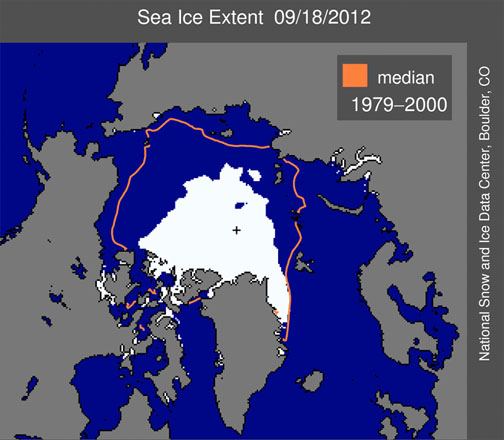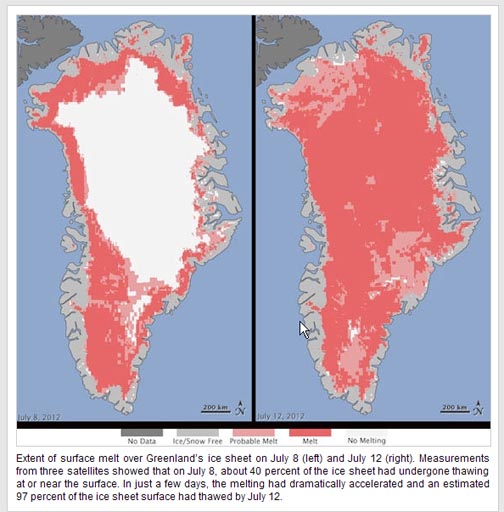[EcoOptimism is not blind. We have our moments of despair. Occasionally, we’ll post a story that tries its damndest to ruin our day raise the alarum.]
The Interwebs have been flooded, as it were, with articles and posts about the record melting of the Arctic icecap. In case you’ve missed the “deluge” (sorry), here are a couple of links – both from the respected site ThinkProgress.org — along with some bullet points added by me to emphasize the significance of this:
‘Astounding’ Record Arctic Ice Melt May Make Weather Extremes More Likely
Earth’s Attic Is On Fire: Arctic Sea Ice Bottoms Out At New Record Low
Extent of Arctic sea ice, at a record low on Sept 16. Image credit: National Snow and Ice Data Center via ThinkProgress.
This is not the same issue as the previous post from the EcoOptimist’s alter ego on the melting of the somewhat nearby Greenland ice cap, but is in many ways more insidious in the feedback loops it creates. It’s several-fold:
- As the ice cap melts, it reflects less heat and, because ocean water is dark colored, absorbs much more heat, which in turn causes more melting … and you can see where this is going.
- But it’s more than that because the warmer air over the arctic causes changes in the jet stream and contributes to an increase in extreme weather and “climate events” like drought, flooding and extreme temperatures.
- The melting ice cap is also theorized to disrupt the Gulf Stream as colder, fresh water infiltrates the North Atlantic, but you all knew that, of course, if you saw “The Day After Tomorrow.”
- And don’t forget that the melting Arctic makes drilling for the oil under it easier. It’s another “positive” feedback loop: melting allows drilling, which allows more burning of fossil fuels, which creates more warming, which….
The EcoOptimist’s first – -and very superficial – reaction is that we need to change the phrase “positive feedback loop” into something less, well, positive.
The more substantial and useful reaction is that environmentally frightening news serves to emphasize still more the need for optimism. The Alter Ego provides the stick and the EcoOptimist brings the carrot (organic, non-GMO, of course).
We return you now to EcoOptimism.





